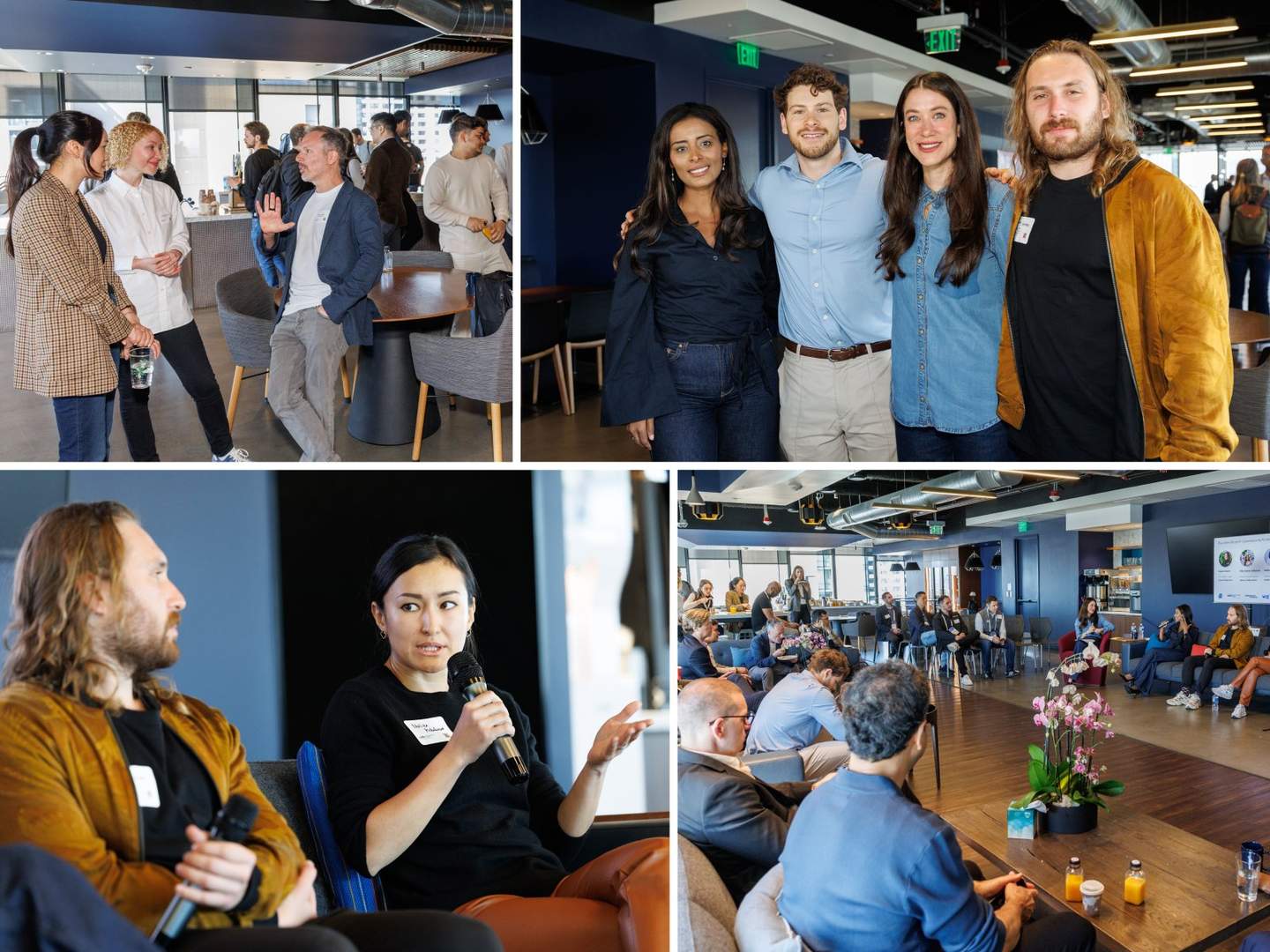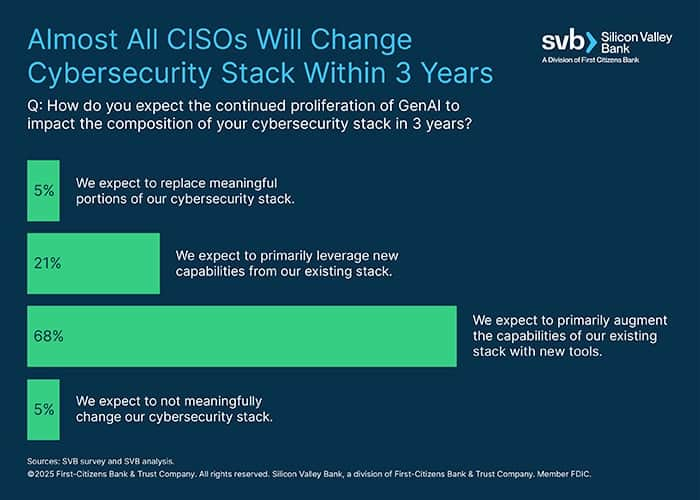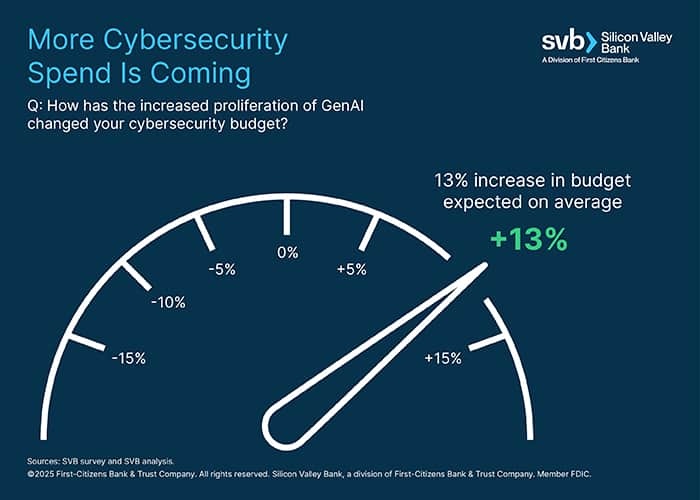- AI is emerging as a critical frontier in cybersecurity – driving innovation while also introducing complex, unprecedented risks.
- The intersection between cybersecurity and AI is no longer a niche segment; it represents the future of security and technology.
- Startup founders must design solutions that don’t just process and report on large quantities of information, they must also act on it – independently and intelligently.
The CyberAI frontier
Artificial Intelligence (AI) is emerging as a critical frontier in cybersecurity – driving innovation while also introducing complex, unprecedented risks. It’s a double-edged sword that requires rethinking how we secure digital infrastructure as the landscape evolves faster than ever. That opportunity has become the dominant thread across this year’s security calendar, from RSA in San Francisco to the Black Hat Conference in Las Vegas.
During RSA in April, Silicon Valley Bank organized a breakfast to host a discussion on CyberAI that brought together leaders from Wiz and Andreessen Horowitz along with Israeli cybersecurity founders attending the conference. The insights that emerged – spanning product, go-to-market and fundraising – continue to resonate as Black Hat approaches in August and CyberAI cements its place at the center of the industry’s future.

An SVB hosted panel discussion on CyberAI
The discussion unfolded against the backdrop of a seismic industry moment – the $32B acquisition of Wiz by Google. This historic deal not only further cemented Israel’s global leadership in cybersecurity but signaled the return of liquidity to the Israeli tech ecosystem. It’s the kind of milestone that stretches the collective imagination of what’s possible, setting the stage for a new generation of talent and founders ready to build the next breakout cyber companies.

Many of the next cybersecurity unicorns are expected to emerge at the intersection of AI. This intersection between cybersecurity and AI is no longer a niche segment; it represents the future of security and technology. During the discussion, the panelists broke CyberAI into two key categories:
- AI for Security – Leveraging AI to detect threats, reduce manual effort and enhance defensive scale across the enterprise.
- Security for AI – Safeguarding GenAI infrastructure, securing model pipelines and managing the risk and governance of autonomous agents.
The new cyber arms race
As AI models become more powerful and accessible, attackers are industrializing exploitation. During the panel discussion, Lazarev warned of new malicious patterns, such as poisoning open-source models and public data sources to manipulate downstream LLM behavior as well as orchestrating agent army attacks. These methods let threat actors automate and scale attacks with unprecedented speed and sophistication. The result: a rapidly evolving arms race where traditional security approaches are no longer sufficient.
On the other side, the same innovations are also empowering the next generation of defenders. Startups are deploying AI to triage massive datasets, detect anomalies in real-time and compress weeks of security operations into hours.

Panelists highlighted key white spaces for cyber founders to build for:
- AI-native detection tools built from the ground up to understand GenAI behavior.
- Supply chain visibility for models ensuring LLMs and datasets used internally or embedded in products are clean and secure.
- Agent governance infrastructure to monitor, manage and control what AI agents can do in enterprise settings.
- Security UX for products that prioritize usability for fast onboarding and lean teams.
Panelist Malika Aubakirova of a16z, emphasized the importance of solving real problems and delivering something truly novel. “Are you fundamentally shifting the workflow for security teams – or just wrapping something old in AI?” she asks. "We’re looking for solutions delivering outcomes only AI makes possible,” she continues.
Building and evolving the cybersecurity stack
According to SVB’s The Rise of CyberAI report, 73% of CISOs surveyed said they planned to “primarily augment” or “replace meaningful portions” of their cybersecurity stacks within the next 3 years (see the chart below). To Aubakirova's point, many CISOs are planning to make changes to their cybersecurity stacks. 
With that level of commitment from CISOs to expand AI capabilities in their cybersecurity stacks, it’s no surprise that cybersecurity budgets are expected to rise by double digits (see below).

In the age of CyberAI, the imperative has evolved from scale to autonomy. Security teams are drowning in tools and alerts. Startup founders must design solutions that don’t just process and report on increasingly large quantities of information, but they must also act on it – independently and intelligently. Autonomous security tools go beyond surfacing anomalies; they investigate, prioritize and respond. Companies building autonomous solutions will stand out by unlocking speed, efficiency and trust in a security environment that can no longer rely on human capacity alone.
Beyond the product
Still, the product is only half the equation. Startup founders must invest early and consistently to earn the trust of enterprise CISOs. Cybersecurity is a relationship business — and credibility opens doors. A strong GTM strategy, partners and community engagement are essential to breaking through.
At SVB, we are proud to support more than 800 cybersecurity companies worldwide and offer specialized tools — including venture debt — to help founders accelerate growth, extend runway and gain early credibility with buyers. Our network of enterprise CISOs and security leaders is an added asset for teams ready to scale.
CyberAI is becoming the defining architecture of modern security. For startup founders, this is more than a technical opportunity. It’s the only viable path forward to protect our information, devices and businesses from an increasingly formidable threat landscape.
Acknowledgement
Thank you to Emma Eschweiler, Director of Corporate Ventures at SVB, Naomi Chetrit Band and Ella Adhanan for sharing their expertise and providing helpful insights for this article.










